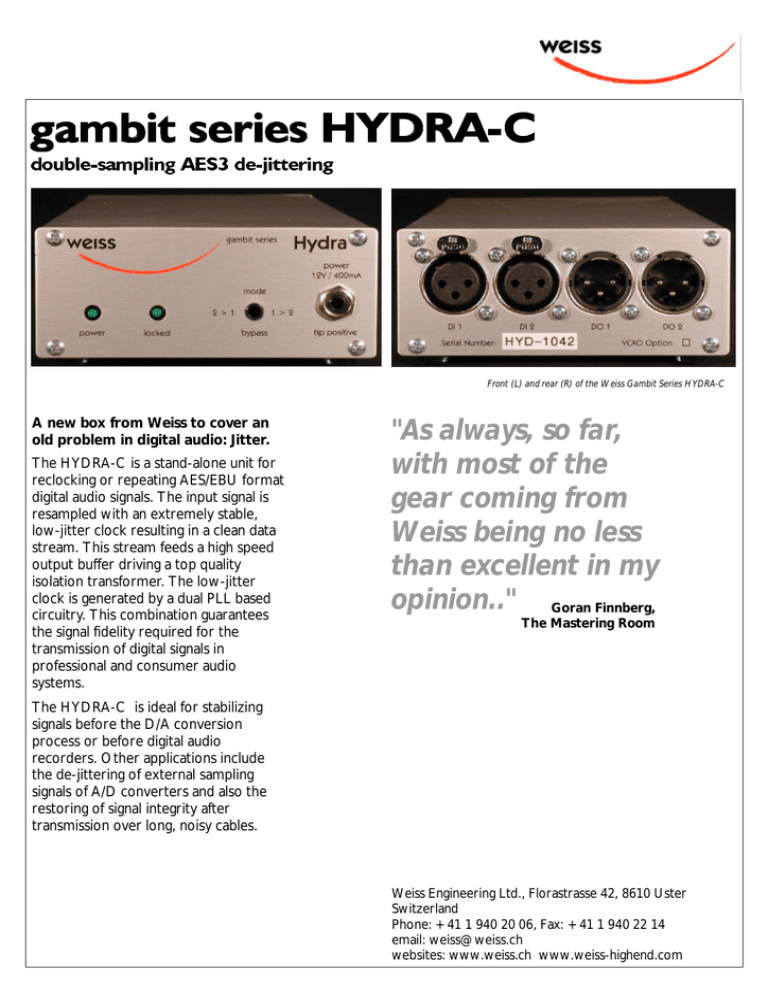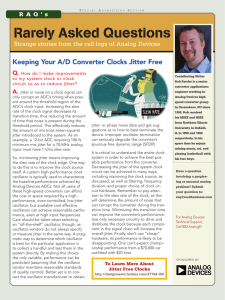"As always, so far, with most of the gear coming from Weiss being no
advertisement

Front (L) and rear (R) of the Weiss Gambit Series HYDRA-C A new box from Weiss to cover an old problem in digital audio: Jitter. The HYDRA-C is a stand-alone unit for reclocking or repeating AES/EBU format digital audio signals. The input signal is resampled with an extremely stable, low-jitter clock resulting in a clean data stream. This stream feeds a high speed output buffer driving a top quality isolation transformer. The low-jitter clock is generated by a dual PLL based circuitry. This combination guarantees the signal fidelity required for the transmission of digital signals in professional and consumer audio systems. "As always, so far, with most of the gear coming from Weiss being no less than excellent in my opinion.." Goran Finnberg, The Mastering Room The HYDRA-C is ideal for stabilizing signals before the D/A conversion process or before digital audio recorders. Other applications include the de-jittering of external sampling signals of A/D converters and also the restoring of signal integrity after transmission over long, noisy cables. Weiss Engineering Ltd., Florastrasse 42, 8610 Uster Switzerland Phone: +41 1 940 20 06, Fax: +41 1 940 22 14 email: weiss@weiss.ch websites: www.weiss.ch www.weiss-highend.com Features , Auto detection of input sampling frequency , Supported input and output sampling frequencies: 44.1 / 48 / 88.2 / 96 / 176.4 / 192 kHz at +- 80ppm tolerance , 24 bit transparent , LED for lock-display , Power-on LED , Transparent Channel Status Data , Two separate AES data streams can be reclocked, AES preambles of both signals have to be phase aligned What is Jitter? What is jitter and how does it affect audio quality? In the audio field the term jitter designates a timing uncertainty of digital clock signals. E.g. in an Analog to Digital Converter (A/D) the analog signal is sampled (measured) at regular time intervals; in the case of a CD, 44100 times a second or every 22.675737.. microseconds. If these time intervals are not strictly constant then one talks of a jittery conversion clock. In practice it is of course not possible togenerate exactly the same time interval between each and every sample. After all, even digital signals are analog in their properties and thus are influenced by noise, crosstalk, power supply fluctuations, temperature etc. Hence a jittery clock introduces errors to themeasurements taken by the A/D, resulting from measurements being taken at the wrong time. One can easily observe that the level of the error introduced is higher during high audio frequencies, because high frequency signals have a steeper signal form. A good designer takes care that the jitter amount in his/her design is minimized aswellaspossible. What type of equipment can be compromised by jitter? There are three types: The A/D Converter as described above, then there is the D/A Converter where the same mechanism as in the A/D Converter applies and the third is the Asynchronous Sample Rate Converter (ASRC). The ASRC is not something usually found in Hi-Fi systems. It is used by Sound Engineers to change the sample rate from e.g. 96kHz to 44.1kHz, or e.g. for putting a 96kHz recording onto a 44.1kHz CD. You may now argue that in High-End Hi-Fi there are such things as "Oversamplers" or "Upsamplers". Yes, those are in essence sampling rate converters, however in a well designed system these converters employ a synchronous design, where jitter does not play any role. Of course a conversion between 96kHz and 44.1kHz as in the example above, can be done in a synchronous manner as well. An ASRC in fact is only required either where one or both of the sampling frequencies involved are changing over time ("varispeed" mode of digital audio recorders) or where it is unpractical to synchronize the two samplingfrequencies. So basically in Hi-Fi jitter matters where there are A/D or D/A converters involved. CD and DVD players are by far the most numerous type of equipment employing D/A converters. And of course stand-alone D/A converters. Jitter, being an analog quantity, can creep in at various places. The D/A converter built into CD or DVD players can be "infected" by jitter through various crosstalk mechanisms, like power supply contamination by power hungry motors (spindle / servo) or microphony of the crystal generating the sampling clock or capacitive / inductive crosstalk between clock signals etc. In the standalone D/A converter jitter can be introduced by inferior cables between the source (e.g. CD player) and the D/A converter unit or by the same mechanisms as described above except for themotorsofcourse. In the case of a stand-alone D/A converter one has to take two different jitter contamination pathes into account. One is the internal path where internal signals can affect the jitter amount of the sampling clock generator. Here, all the good old analog design principles have to be applied. Such as shielding from electric or magnetic fields, good grounding, good power supply decoupling, good signal transmission between the clock generator and the actual D/A chip. The other path is the external signal coming from the source to which the sampling clock has to be locked. I.e. the D/A converter has to run synchronous to the incoming digital audio signal and thus the frequency of the internal sampling clock generator has to be controlled so that it runs at the same sampling speed as the source (CD player). This controlling is done by a Phase Locked Loop (PLL) which is a control system with error feedback. Of course the PLL has to be able to follow the long term fluctuations of the source, e.g. the sampling rate of the source will alter slightly over time or over temperature, it will not be a constant 44.1kHz in the case of a CD. But the PLL should not follow the short term fluctuations (jitter). Think of the PLL as beeing like a very slow-reacting fly-wheel.



